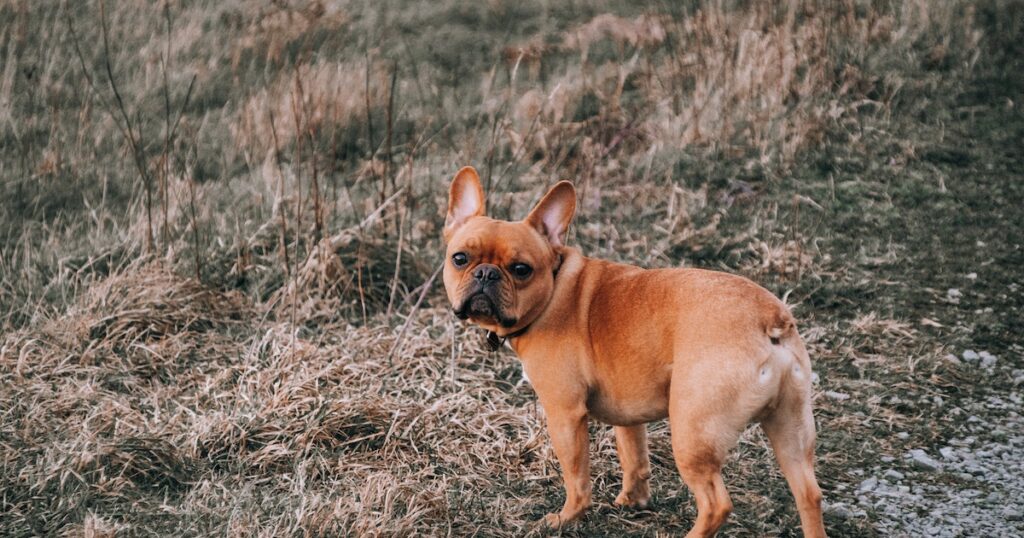They are one of the best known and most loved dogs in the world. We quickly recognized it by its large ears and flat snout. We could only be talking about the French Bulldog. Find out all about the breed.
French Bulldog Appearance
With an average life expectancy of 11 to 13 years, French Bulldogs are small animals. It is a case to say that dogs are not measured by the hand. If we take their measurements, they can measure up to 35 cm and, on the scale, adult males can reach up to 12.5 kg and females up to 11 kg.
When looking at it, we highlight the flat snout, with salient and striking folds. The nose is also flattened, wide and short.
With short hair, it is possible to find this breed in several colors: white, black, spotted, beige, gray or brindle.
Personality
These dogs will become the protagonist of the house. They are well-disposed and very affectionate animals. They have a very strong bond with their owners and therefore need a lot of attention . Usually, when they don’t get it, they can become destructive.
Also noteworthy is the courageous, affectionate, intelligent and sweet personality . Even if they are stubborn, they have exemplary behavior. You will also like to know that they are dogs that bark little. They love to play and get along well with other furry friends and children.
The ideal dog for every member of the family
With or without children, single or married, the French Bulldog will always be a good choice. It is a good option for older people who are looking for a four-legged companion. It adapts well to small spaces, so living in an apartment doesn’t have to be a hindrance. Just avoid him climbing stairs very regularly, due to his small legs and spine.
If you have children, it is important that they understand that, although the dog loves to play, he always needs his moments of rest. They will certainly be inseparable friends.
The ancestors of the French Bulldog
The story of the Bulldogs could well make a movie. Curious? There is a dispute between the English and the French, who do not seem to agree on the origin of this breed.
On the one hand, we hear the French defend that these dogs were born in the popular Parisian neighborhoods, the result of several crossings of lesser known breeds. However, the British say that this breed descends from the small English Bulldogs that, since they weren’t much required in their homeland, ended up being sent to France, where they were crossed with indigenous dogs.
There are also theories that argue that they are descendants of the Tibetan or Asian Dogue and that, when imported to England, they were crossed with Terriers. The truth is that when they started to appear in France, they already had characteristics of the current French Bulldog.
They were first used as rat-catchers, but quickly gained fans in the suburbs of Paris. It is in 1880, in the Parisian city, that the first French Bulldog club is born. Eight years later, after the breed standard had already been established, the dog Loupi became the recognized patriarch, and is mentioned in the vast majority of books on the genealogy of the breed.
From that moment on, the breed became popular among dog lovers, even to this day.
Most Common Diseases of Bulldogs
Do not expose your Bulldog to fumes or overly aggressive cleaning products. Although we all find a flattened nose irresistible, the truth is that it has consequences for the dog, such as difficulty breathing . This condition prevents you from controlling your internal temperature and, therefore, the sun and excessive physical exercise can be very harmful to your health.
This breed is also very susceptible to eye and heart problems . Excess weight can also compromise the well-being of French Bulldogs.
Among other pathologies that usually affect these dogs are skin infections, hip and elbow dysplasia – which can cause joint disease and compromise their mobility – and vertebral disorders .
In addition to regular visits to the veterinarian, their health also involves deworming and vaccination . Don’t forget that prevention is always the best medicine.
A guide to caring for your pet
Bringing a dog home means being aware of the care they need. Hygiene, food or exercise. Find out about the main precautions that you cannot forget if you have a Bulldog.
Hygiene
Since they have short hair, brushing them once a week is enough . On the other hand, facial wrinkles should be cleaned regularly to avoid allergies and infections. Also be aware of your four-legged companion’s ears.
Food
Bulldogs that are growing need up to four meals a day. Adults only need two meals a day. If possible, they should go for a walk before mealtime and rest afterward.
Make sure your dog always has water available. Before buying any feed, check with your veterinarian to find out which diet is best for your faithful companion.
Know also that this breed is quite subject to allergies, both food and environmental. In order to mitigate the former, it is important to opt for hypoallergenic rations. In turn, environmental allergies require constant veterinary monitoring, as they can lead to very uncomfortable clinical conditions for animals.
Other important tips
This is a breed that does not need a lot of physical exercise. One hour a day is recommended . Opt for “workouts” that don’t demand too much from them, but which, at the same time, stimulate their intelligence.
Take short walks , without walking too fast, and ensure that the animal is protected from the heat, to avoid heatstroke or further worsen its difficulty in breathing. In the summer, for example, go out with him first thing in the morning or at the end of the day.
As already mentioned, its physical condition does not allow it to withstand extreme heat. It’s easy to see why the French Bulldog prefers indoors to outdoors and cool places when it’s time for a walk.
Be aware of the animal’s falls, as their eyes are more prominent than usual, making this area extremely sensitive.
Not to forget:
- Small in size, the French Bulldog stands out for its flat muzzle and nose.
- They are very affectionate, affectionate, intelligent and playful dogs. They bark little and coexist without problems with other dogs and children.
- Breathing difficulties, eye and heart problems, skin infections, hip and elbow dysplasia and vertebral disorders are the main pathologies that affect these animals.
- They only need to be brushed once a week.
- Walks should be short and physical exercise should not exceed one hour a day.


